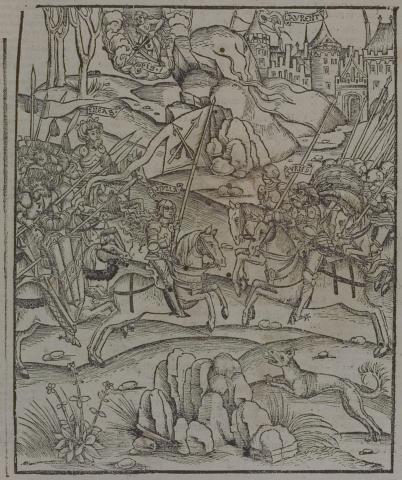Annotations
Turnus and his troops ride from the right of the image to a place outside the fortress, ready for battle (486-97). Camilla and her troops meet him (498-501), arriving from the left. The standard she carries has two crossed arrows, symbolizing her close relationship with the goddess Diana (532-86). Turnus asks her to meet the Trojan cavalry that are advancing in the field, so that he may face Aeneas (507-21). At the top of the image, the goddess Opis, who is part of Diana's retinue, points a bow and arrow at Aeneas, who is placed close to the troops of Camilla, but is not meant to be associated with them. The arrow is pointed at Aeneas because one of his men is destined to kill Camilla, and Diana intends for the perpetrator to die for his actions by the hand of Opis (587-96). The dog in the lower right corner would be appropriate in a hunt scene, but it is a bit out of place here.
Woodcut illustration from the “Strasbourg Vergil,” edited by Sebastian Brant: Publii Virgilii Maronis Opera cum quinque vulgatis commentariis expolitissimisque figuris atque imaginibus nuper per Sebastianum Brant superadditis (Strasbourg: Johannis Grieninger, 1502), fol. 383r, executed by an anonymous engraver under the direction of Brant.


Sebastian Brant (1458-1521) was a humanist scholar of many competencies. Trained in classics and law at the University of Basel, Brant later lectured in jurisprudence there and practiced law in his native city of Strasbourg. While his satirical poem Das Narrenschiff won him considerable standing as a writer, his role in the transmission of Virgil to the Renaissance was at least as important. In 1502 he and Strasbourg printer Johannes Grüninger produced a major edition of Virgil’s works, along with Donatus’ Life and the commentaries of Servius, Landino, and Calderini, with more than two hundred woodcut illustrations. (Annabel Patterson)